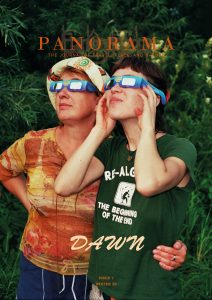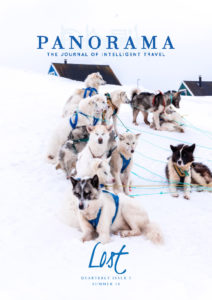In my beginning is my end. Now the light falls
Across the open field, leaving the deep lane
Shuttered with branches, dark in the afternoon.
An excerpt from T.S. Eliot’s ‘East Coker’ from The Four Quartets, inscribed around a blue limestone roundel at the beginning of the Cotswold Way in Chipping Campden.
*****
I am standing barefoot on the soft green brow of Cleeve Hill, the highest point in Gloucestershire, holding up a faded cream-cotton parasol against the hot sun. I can see straight across the Vale of Evesham, to the blue swell of the Malvern hills, rising up through the heat haze, and then further still to the dark Welsh mountains on the distant horizon, sprawled like heraldic dragons en dormant.
Midsummer morning and we’ve only walked a couple of miles, but it’s far too beautiful here not to stop. My six-year-old boy sits cross-legged by my side eating sweet plum tomatoes from a cardboard punnet; my husband is stretched out next to him, looking at Ordnance Survey maps on his phone. The sky is the colour of medieval soda glass, the thin blue of wild chicory, of harebells. Skylarks are hovering high above, their peep-peep song delicate and fragmented in the upland breeze.
The trackway we have been following crosses the sheep-sward behind and ahead of us, arching down and out of sight along the long crest of the hill: The Cotswold Way. One of the loveliest trails in England, it stretches 102 miles along the high escarpment known as the Cotswold Edge. Rhythmically climbing and descending, it tumbles down through dark, still beech woods to the valleys and villages below, all cow bellows and bird song and church bells, then up steep field paths edged with willow-herb, meadowsweet and scarlet poppies, to the intoxicating wind, sun and rain of the pagan high hills, where the track winds through Iron Age forts and adder-haunted heaths. Golden, black-spiked gorse, seed pods popping in the sun, rule the uplands: standing guard in these ancient silent places.
We are walking from the northern terminus of the Way, which lies in the wool town of Chipping Camden, next to the market hall, a honey-stoned loggia built for £90 in 1627 by James I’s moneylender, Sir Baptist Hicks. (Hicks was a kindly friend to wayfarers, illuminating the ‘very capacious dome’ of his house at great expense each night for the direction of travelers on the hill tops.)[1] To the south, it concludes elegantly in front of the great West entrance of Bath Abbey, overseen by a carved Jacob’s ladder of efficient limestone angels precipitously ascending and descending from earth to heaven and back again; a superlunary version of the up-and-down of the Cotswold Way, and these are, without doubt, Cotswold angels with stout boots and good lungs, used to vertiginous climbs.
Although only officially inaugurated as a National Trail in 2007, the idea of one maintained, long-distance track across the Cotswolds had been mooted for years and was first established as a coherent route in 1970. One contiguous pathway composed of polyphonic variations on the same theme of stone and earth and hedgerow: a knitting together of pilgrim paths, salt and drovers’ roads, stony Roman marches, cut-purse thorn tracks, damp, ferny hollow ways, Puck lanes heady with faerie elderflower and hawthorn, wind-whipped barrow climbs, and the stalwart workaday paths of Cotswold country folk and their beasts – run, walked, gambled, skittered, rolled-down, and trudged by women, children, men, sheep, horses, geese and cattle for centuries, in snow, rain, hail and sun.
In 1973, Mark Richards, a local Cheltenham farmer, produced the first guide to the full walk, in the style of his friend, the fell-walker Alfred Wainwright, who wrote the introduction. His detailed hand-drawn maps and drawings are charming and informal, but slightly melancholic to look at now in our hard, connected age, with their sun-dappled early 1970s pastoralism.
Earlier, during the interwar period, there was a surge of interest in walking the sweet green lanes of England which saw the Cotswold meadow paths “all ‘a ripple with mirth’ at the merry bands…touring the countryside on foot.”[2] In 1924, rooted in this popular wayfaring revival, Algernon Gissing, a solicitor and novelist of negligible sales and wildly uneven genres (his works range from the Gothic Master of Pinsmead to Knitters in the Sun and Love in the Byways), produced a lyrical masterpiece of topographical and nature writing: The Footpath Way in Gloucestershire.
Gissing’s extensive knowledge of the North Cotswolds, of the wild field and hedge flowers, butterflies, trees, and birds, his sensitivity to the changing landscape and underlying sense of environmental duty, cast it still relevant and companionable today. The guide ends with Algernon standing in deep snow on the crest of Saintbury Hill, near the village of Broadway, one of the main stops on the Cotswold Way. (I imagine him in a heavy greatcoat, favourite pipe in mittened hand, stamping his feet against the cold.) It’s midnight on New Year’s Eve, and in the expectant darkness, he begins to hear the call and response of church bells across the valley below:
My nearest peal chanced to be a little more than a mile away [and] I could hear six or seven others in the marvellous serenity of that night…exquisite patches of snow white clouds were overhead [and] we were in absolute stillness below. A few minutes before the clock struck, the bells sank to a solemn toll, and the old year was gone. Then for New Year’s morning, they suddenly broke again into jubilant peals. Two or three owls were hooting….and just before midnight came the plaintive notes of a plover in a distant field, aroused…by the bells. Amidst such a scene, and to such a unanimity of voices, how escape thoughts of the heart of England.[3]
That unanimity of voices is a mark of the Cotswold Way. There’s a timeless concordat of physical and oneiric experience of every wayfarer who knows and walks its paths. It enables me to read accounts by Gissing or Richards, and feel a sense of deep kinship rooted in our shared footsteps across the land. I, too, have climbed up Rudge Hill, with kestrels calling and circling overhead. I, too, have hurried through Standish Woods in the fading light. I, too, have stood on Haresfield Camp and seen the rain swept seaward across the River Severn from the Brecon Beacons, great shafts of storm-bruised yellow sunlight moving over the countryside like wartime searchlights.
A Cotswold Book by H. W. Timperley, illustrated with austere, unsentimental pen-and-ink sketches by Lowry has this same profound sense of intimacy from shared somatic exertion, topographical experience, memory and imagination. Timplerley was a chorographer in the old Elizabethan sense of the word, and the accounts of his rambles are romantic and personable; echoing Kipling’s Puck of Pook’s Hill in their invocation of the historical palimpsest of the greenways and the high lonely places. His 1931 book became a constant companion to me on the Way. My frayed red cloth-bound copy is borrowed from the London Library, as a ‘country loan’, and its last owner was another enthusiast, a Miss M.C. Pantin, whose name is inscribed and dated (July 1932) in spidery black copperplate on the flyleaf.
As I read Timperley’s words, I trace my own walks in my mind, and we and Miss Pantin converse across the century, across war and death and rural change – “It was nearly noon before I climbed the road up Sudeley Hill with the sun slowly coming through the haze,” “I cannot imagine brighter and clearer sunlight than that which fell upon Belas Knap on this May morning,” “You do not know what quietness is until you are alone at midday on a high Cotswold road under a cloudless sky which bends over you in a span so wide that the sun seems becalmed in an endless noon.”[4]
Of all those who sing and have sung the ancient Cotswold tracks, however, no voice is more poignant than the pastoral composer and poet, Ivor Gurney. Born in 1890, Gurney, the brilliant son of a Gloucester tailor, won scholarship after scholarship as a boy, singing as a chorister at Gloucester Cathedral and eventually studying under the tutelage of Sir Charles Stanford and Ralph Vaughan Williams at the Royal College of Music in London. He suffered from what was probably schizophrenia, however, inevitably exacerbated by shell shock from his service as a private in the 2nd/5th Gloucesters in the First World War, and, after a burst of incandescent creativity producing an exquisite body of music and poetry, he spent the last fifteen years of his life in the City of London Mental Hospital in Dartford, unpublished, desperately unhappy and longing for his beloved ‘hills of home.’[5]
In 1917, he had been invalided out of Flanders, gassed during the Passchendaele offensive at Ypres. Part of a small unit carrying heavy machine gun parts, the physical effort was too onerous to wear gas masks, and the fumes from mustard gas – the same sweet scent as the wild garlic of his boyhood woodlands – pooling in puddles from a previous attack, soon overcame the group, sending them back to Blighty without firing a single shot.
A month later, whilst recuperating, Gurney’s first slim volume of verse, Severn and Somme was published. From his first few days in northern France, the landscape of the Somme had reminded Gurney of his beloved Gloucestershire, of the Cotswold hills and water meadows, and the “wide Severn river, homing again to the sea.” Amidst the endless artillery bombardment and tangle of noise and wire and dread, he found himself both dislocated and deeply comforted by living simultaneously in these two intersecting topographies. Gurney wrote to his friend Marion Scott, “Out of the window we can watch men making hay in a fashion reminding us distractingly of Home. They are easily in range of the smallest field guns.”[6] In another letter, he writes guiltily of the strange beauty of this disturbing oscillation between two realities, as it affected many of the young country-born soldiers, just about holding their nerve in a hell of no man’s land:
“Once we were standing outside our dugout cleaning mess tins, when a cuckoo sounded its call from the shattered wood at the back. What could I think of but Framilode, Minsterworth, Cranham, and the old haunts of home. This Welshman turned to me passionately. ‘Listen to that damned bird,’ he said. ‘All through that bombardment in the pauses I could hear that infernal silly ‘Cuckoo, Cuckoo’ sounding while Owen was lying in my arms covered in blood. How shall I ever listen again…!’ He broke off, and I became aware of shame at the unholy joy that filled my artist’s mind. And what a fine thin keen face he had, and what a voice.”[7]
As I continued to walk the full length of the Cotswold Way, husband and small son in tow, Gurney was constantly on my mind. His tragic life, a trajectory of extraordinary promise, fragmented by war, mental illness, and degrading and dangerous treatment (at one point he was injected with malaria to ease his delusions through fever), had become inextricably linked with my own vision of the landscape. I thought of him that day on Cleeve Hill, when I suddenly picked out, within the immensity of earth and sky spread before me, my own site of bombardment, of catastrophic pain.
Towards the west, the Regency spa resort of Cheltenham sprawls unevenly. I could see the vast racecourse and the ugly intelligence-gathering fortress of GCHQ, and a little further in the distance, blurred by the heat, the solemn grey portico of the Cheltenham General Hospital.
It was the hospital where, a decade ago, my mother, Felicity, had her last futile chemotherapy for metastatic breast cancer. Down there somewhere was the drab, fluorescent-lit family room where I realized that all hope was gone, that she would die and soon, and there was absolutely nothing I nor anyone else could do. That foggy November afternoon in 2008 suddenly rushed back to me: the memory of the disinfectant lemon smell of the ward hitting me unexpectedly like Gurney’s burst of yellow mustard gas. The hot NHS tea in heavy eau-de-Nil cups and saucers, the special chocolate biscuits for the cancer patients, nipping out to buy her a Christmas present and crying in the middle of Montpellier Street, the long wait for a free ambulance to taxi her back home, to my home, in Northleach, a stout Cotswold wool town on the old Fosse Way.
She died two weeks after that visit, on the morning of Armistice Day, just before the two-minute silence. I held her delicate hand as she took her last faint breath. After she died, I opened the heavy sash window in the little whitewashed bedroom and saw a straggle of old gentlemen heading to the town’s war memorial with poppy wreaths hooped over their arms.
Memory is not static, it is not singular; we remember collectively, not alone. The entangled paths of remembrance and redemption wind through landscapes both of dark bombardment and sweet meadow blossoms. At the very end of Gurney’s life, when he was suicidal and so utterly alone, the widow of the poet Edward Thomas, who was killed at the Battle of Arras at Easter 1917, came to visit him. Inspired, she brought an Ordnance Survey Map of Gloucestershire, writing later that:
“This proved to have been a sort of inspiration, for Ivor at once spread it out on his bed and he and I spent the whole time I was there tracing with our fingers the lanes and byeways and villages of which he knew every step and over which Edward had walked. He spent that hour in re-visiting his beloved home, in spotting a village or a track, a hill or a wood and seeing it all in his mind’s eye, a mental vision sharper and more actual for his heightened intensity. He trod, in a way we who were sane could not emulate, the lanes and fields he knew and loved so well, his guide being his finger tracing the way on the map. It was most deeply moving, and I knew that I had hit on an idea that gave him more pleasure than anything else I could have thought of.”[8]
*****
Endnotes
[1] ‘Sir Baptist Hicks’, Middlesex County Records: Volume 4, 1667-88, ed. John Cordy Jeaffreson (Middlesex County Records Society, 1892), pp. 329-349.
[2] Journalist Fred Hando writing in the South Wales Argus in 1934, quoted by Robert Macfarlane in his introduction to Alfred Watkins’ Old Straight Track (1925, republished by Head of Zeus in 2014)
[3] Algernon Gissing, The Footpath Way in Gloucestershire (Dent, 1924)
[4] H. W. Timperley, A Cotswold Book (Jonathan Cape, 1931)
[5] ‘Crickley Hill’, Severn and Somme (Sidgwick and Jackson, 1917)
[6] R.K. R Thornton, Ivor Gurney: Collected Letters (Carcanet Press, 1991), p.103.
[7] Pamela Blevins, Ivor Gurney & Marion Scott: Song of Pain and Beauty (Boydell & Brewer, 2008), p.96.
[8] Helen Thomas, ‘Ivor Gurney’, in Time and Again: Memoirs and Letters, ed. Myfanwy Thomas (Carcanet, 1978), pp.110-12.











